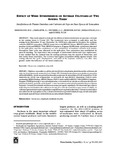Por favor, use este identificador para citar o enlazar este ítem:
http://www.alice.cnptia.embrapa.br/alice/handle/doc/981724| Título: | Effect of weed interference on soybean cultivars at two sowing times. |
| Autor: | MARANGONI, R. E.  JAKELAITIS, A.   TAVARES, C. J.   REZENDE, B. P. M.   MELLO FILHO, O. L.   CUNHA, P. C. R.   |
| Afiliación: | IF GOIANO IF GOIANO IF GOIANO IF GOIANO ODILON LEMOS DE MELLO FILHO, CNPSO IF GOIANO. |
| Año: | 2013 |
| Referencia: | Planta Daninha, Viçosa, MG, v. 31, n. 3, p. 511-519, July/Sept. 2013. |
| Descripción: | ABSTRACT: This study aimed to evaluate the effects of weed interference on soybean cultivars at two sowing times in Urutaí, GO. The treatments were arranged in split-plots, and the sowing times (November 16 and December 16, 2009) were allocated in the plots; the soybean cultivars [BRSGO Amaralina, P98C81 (semi-late cycle) BRSGO Raissa, BRSGO Indiara, P98Y11 (median cycle) and BRSGO 7560, BRSGO Caiapônia, Emgopa 302RR (early cycle)] were allocated in the split-plots; and the coexistence or non coexistence of soybean cultivars with weeds, throughout their cycle, was allocated in the split-plots. Non coexistence was established by manual weeding. The experiment was arranged in randomized blocks with four replications. It was verified that the optimal time for sowing soybeans was the month of November, and that under these conditions, the cultivars had higher competitive ability against weeds. Late sowing affected the cycle, development, and yield of the soybean cultivars; this effect was greater under the influence of the weed community. RESUMO: Objetivou-se avaliar os efeitos da interferência de plantas daninhas sobre cultivares de soja, em duas épocas de semeadura em Urutaí, GO. Os tratamentos foram arranjados em parcelas subsubdivididas, sendo nas parcelas alocadas as épocas de semeadura (16 de novembro e 16 de dezembro de 2009); nas subparcelas, os cultivares de soja [BRSGO Amaralina, P98C81 (ciclo semitardio), BRSGO Indiara, BRSGO Raíssa, P98Y11 (ciclo médio) e BRSGO 7560, BRSGO Caiapônia, Emgopa 302RR (precoce)]; e nas subsubparcelas, a convivência ou não de os cultivares de soja com plantas daninhas, por todo o ciclo destas. A não convivência entre eles foi estabelecida por capinas manuais. O ensaio foi montado em blocos ao acaso com quatro repetições. Foi observado que a época indicada para semeadura dos cultivares de soja foi o mês de novembro e que, nessa condição, os cultivares apresentaram maior capacidade competitiva com as plantas daninhas. O atraso na semeadura dos cultivares de soja afetou o ciclo, o desenvolvimento e a produtividade da soja, sendo esse efeito maximizado quando houve a interferência da comunidade infestante. |
| Thesagro: | Soja |
| ISSN: | 0100-8358 |
| DOI: | 10.1590/S0100-83582013000300003 |
| Tipo de Material: | Artigo de periódico |
| Acceso: | openAccess |
| Aparece en las colecciones: | Artigo em periódico indexado (CNPSO)  |
Ficheros en este ítem:
| Fichero | Descripción | Tamaño | Formato | |
|---|---|---|---|---|
| Effectofweedinterferenceonsoybeancultivarsattwosowingtimes.pdf | 1.68 MB | Adobe PDF |  Visualizar/Abrir |









